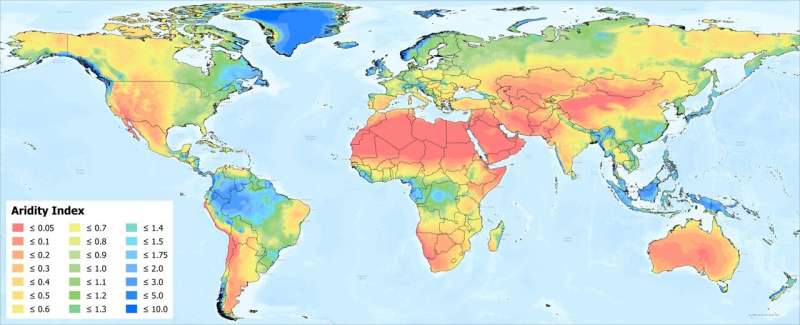Global Aridity Index (Global-AI_v3), based upon the FAO-56 Penman Monteith equation for reference evapotranspiration (ET0) calculated for the entire globe. Note that higher AI_ET0 (green/blue colors) represents more humid conditions, with low AI (yellow/brown/red colors) representing higher aridity. Credit: Scientific Data (2022). DOI: 10.1038/s41597-022-01493-1
An international team of scientists has released the updated and improved estimations of Potential Evapotranspiration and an Aridity Index for the entire world based upon a fully parameterized geospatial implementation of the Penman-Monteith Equation, a widely used standard methodology.
The peer-reviewed article describing the database, published in Scientific Data, has provided a technical evaluation for datasets using real-world weather station data.
The database has proven to be a valuable global public good. Already available online back in 2009, its earlier versions have been downloaded nearly 50,000 times, applied across disciplines, and has nearly 1,500 citations on topics ranging from agriculture and natural resource sciences to genetics, anthropology, archaeology, conflict resolution, and climate change.
"These datasets have been found useful across a wide variety of applications, particularly related, but not limited to water management and crop production, but also socio-ecological and socio-economic applications addressing sustainable development and climate change and can be particularly useful for local adaptation to global change," said Dr. Robert Zomer, a Presidential Fellow at the Kunming Institute of Botany of the Chinese Academy of Sciences(KIB/CAS), as well as the lead author of the study.
"The high resolution of Global Aridity Index provides great potential to map climatic-related and environmental risks for human and all form of life with the need for water, and is therefore important for conservation and development planning," said Prof. Xu Jianchu from KIB, a principal scientist of World Agroforestry Center.
Topics of papers citing this dataset range from global environmental issues such as drought and wildfires, to human migration, pastoralism and desertification, wildlife and restoration ecology, child mortality, and epidemiological and other human and livestock health research, such as the effect of malaria control, or mapping the zoonotic niche of Ebola virus disease in Africa.
Dr. Antonio Trabucco of the Centro Euro-Mediterraneo sui Cambiamenti Climatici (CMCC) emphasized the utility of this new, latest release, saying, "Not only is the data improved, but publishing the source code used to develop this analysis makes it available for local and specific applications using local data, improved, or updated climate data. We think that this database and its source code provide robust tools that can help to meet the challenges of a rapidly changing global aridity environment."
More information: Robert J. Zomer et al, Version 3 of the Global Aridity Index and Potential Evapotranspiration Database, Scientific Data (2022). DOI: 10.1038/s41597-022-01493-1
Journal information: Scientific Data
Provided by Chinese Academy of Sciences























